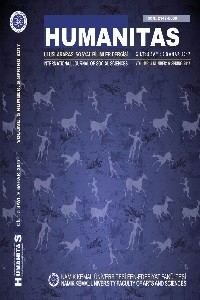Öz
This research, in which one of the Giorgione painting has specifically been chosen, aims to analyze the philosophical dimensions related to typical elements of a renaissance landscape. Thus the Tempesta (the Storm) of Giorgione is a good example of a pastoral landscape of this period; with all its ambiguous that has been widely discussed and researched by several theoreticians and art historians until today. In this research, we tried to bring up some of the philosophical expansions related to this painting of Giorgione, in terms of the visual language of renaissance period landscape painting. This research which focuses on Giorgione, Renaissance and landscape painting has been constructed in the axis of some of the important thinkers and theoreticians from different periods like; Aristotales, Alexandre Gefen, Gaston Bachelard, Jean-Paul Brun, Marsile Ficin, Marcelin Plenet, Manfred Wundram, Georg Wilhelm Friedrich Hegel and Salvator Settis known especially with his researches on Giorgione’s paintings. Based on these names, together with analyzing this painting of Giorgione, we tried also to handle some notions like poesie, spirituality, pastoral, picturesque which appears in the context of the visual impact of landscape image. We tried handle to the metaphorical expansions of figures on foreground, natural event (storm) in the background, complementary descriptions like the bride etc. and the particular settlements of renaissance art by taking advantage of the specified theoreticians’ interpretations. As a result, another aim of writing this article has become to establish an original synthesis, based on certain philosophical theories, reviewing some of notable interpretations on this painting.
Kaynakça
- Bachelard, G. (1984). La Terre et les Rêveries du Repos, Paris: Librairie Jose Corti.
- Brun, J.,P, (2005). Nature, Art Contemporain et Société, Le Land Art Comme Analyseur, Volume, Nature Sauvage, Contre-Culture et Land Art, Préface de Bruno Pequignot, Paris, l’Harmattan.
- Gefen, A. (2002). La Perception du Paysage dans La Renaissance, Information publiée le 21 Mai 2002 sur la revue en ligne Fabula ; La Recherche en Littérature (http://www.fabula.org/actualites/la-perception-du-paysage-dans-la-renaissance_3931.php)
- Ficin, M. (2001). Les Platonismes a La Renaissance, Collection Philologie et Mercure, Sous La Direction de Pierre Magnard, Paris, J. Vrin.
- Hegel, G., W., F. (1979). Introduction à l’Esthétique, le Beau, Paris, Champs, Flammarion.
- Plenet,M. (1991), Giorgione et Les Yeux Venus, Paris, Maeght.
- Wundram, M. (2006), Renaissance, Igno F. Walther Taschen, Germany.
Essai sur un paysage de la Renaissance: La tempete de Giorgionne (Bir Rönesans Manzarası Üzerine Deneme: Giorgione’nin Fırtınası)
Öz
Cette recherche dans laquelle on a choisi spécifiquement une
peinturede Giorgione, s’intitulant LaTempesta (Fr. la tempête), a pour
objectif d’analyser les dimensions philosophiques liées aux éléments
typiques d’un paysage de la Renaissance. Cependant, La Tempestaest un
bon exemple pour un paysage pastoral de cet époque-là; avec toutes ses
ambiguïtés qui sont largement discutées et recherchées par divers
théoriciens et historiens d’art jusqu’à aujourd’hui. Dans cette recherche,
on s’est proposéd'évoquer certaines expansions philosophiques de cette
peinture, en termes de langage visuel du paysage de la Renaissance. Cette
recherche qui s’est focalisée sur Giorgione, la Renaissance et la peinture
de paysage, a été construite selon le point de vue de certains penseurs et
théoriciens importants des périodes différentes comme;Aristotales,
Alexandre Gefen, Gaston Bachelard, Jean-Paul Brun, Marsile Ficin,
Marcelin Plenet, Manfred Wundram, Georg Wilhelm Friedrich Hegel et
Salvator Settis, connu surtout avec ses recherches sur les peintures de
Giorgione. Dans le cadre des approches de ces théoriciens, nous avons
essayé de traiter,dans la peinture de Giorgione, certaines notions comme;
la poésie, la spiritualité, le pastorale, le pittoresque qui apparaissent dans
le contexte de l'impact visuel de l'image du paysage.Nous avons
également viséà traiter les expansions métaphoriques des figures sur le
premier plan, l'événement naturel comme tempête en arrière-plan, des
descriptions complémentaires comme le pont, etc. autour des analyses
particulières de la Renaissance.Par conséquent, nous nous sommes permis
de mettre en place une synthèse originale, en nous appuyant sur certaines
théories philosophiques et en révisant quel que otable interprétations sur
ce tableau-là.
Anahtar Kelimeler
Kaynakça
- Bachelard, G. (1984). La Terre et les Rêveries du Repos, Paris: Librairie Jose Corti.
- Brun, J.,P, (2005). Nature, Art Contemporain et Société, Le Land Art Comme Analyseur, Volume, Nature Sauvage, Contre-Culture et Land Art, Préface de Bruno Pequignot, Paris, l’Harmattan.
- Gefen, A. (2002). La Perception du Paysage dans La Renaissance, Information publiée le 21 Mai 2002 sur la revue en ligne Fabula ; La Recherche en Littérature (http://www.fabula.org/actualites/la-perception-du-paysage-dans-la-renaissance_3931.php)
- Ficin, M. (2001). Les Platonismes a La Renaissance, Collection Philologie et Mercure, Sous La Direction de Pierre Magnard, Paris, J. Vrin.
- Hegel, G., W., F. (1979). Introduction à l’Esthétique, le Beau, Paris, Champs, Flammarion.
- Plenet,M. (1991), Giorgione et Les Yeux Venus, Paris, Maeght.
- Wundram, M. (2006), Renaissance, Igno F. Walther Taschen, Germany.
Ayrıntılar
| Bölüm | Tüm Sayı |
|---|---|
| Yazarlar | |
| Yayımlanma Tarihi | 3 Ağustos 2017 |
| Yayımlandığı Sayı | Yıl 2017 Cilt: 5 Sayı: 9 |









